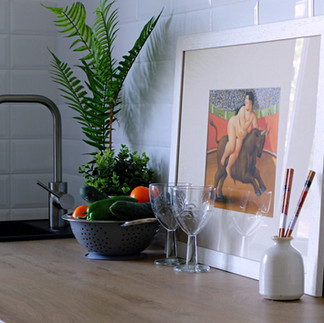Designing a Home That Tells Your Story
- KSIisgoodliving

- Jun 27
- 4 min read
Photography by Unsplash, courtesy of K Smith Interiors
In a world driven by trends, Pinterest boards, and mass-produced home décor, how do we bring true personal style and authenticity into our homes?
As an interior designer, it’s my privilege to style homes for my clients. I love walking through their spaces and learning the details of how certain pieces came into their lives—how long they’ve had them, who gifted them, or what random shop they found them at.
Most people don’t walk their friends and family through their homes, sharing stories about their objects and furniture. I get to do this all the time—it’s like giving a guided museum tour of someone’s life through their personal artifacts. And it’s interesting how many things people display in their homes that they actually don’t like.
“I hate this chair; it’s so uncomfortable.”
“This is a stupid thing I picked up at Target because I needed shoe storage.”
“This was my husband’s grandmother’s… he loves it—I hate it!”
It’s pretty entertaining. But my favorite part is when I see a great piece and ask about it. That’s when they light up—remembering how much they adore the item and how it brings them joy. That’s when I know exactly how the room needs to be styled.

Photography by Unsplash, courtesy of K Smith Interiors
Editing Is Part of the Process
Here’s something people are often surprised to hear: part of my job is to edit spaces.
When I first meet with a client, I’m actually gathering information to “program” their space. Yes, that includes function and flow—but more importantly, it’s about how they want the space to feel.
A while ago, I worked with a company to style homes for professional photo shoots. The focus was on highlighting beautiful custom cabinetry. I brought in just a few items—fresh flowers and small décor touches. But the biggest part of the shoot wasn’t the styling—it was the editing. I brought moving boxes and removed nearly all of the homeowner’s décor.
Why? Because I wasn’t there to capture their everyday life—I was there to make the cabinets the main character of the photo. That’s what I was hired to do.
The point is: your décor—or the absence of it—starts telling the story of your space. And how you feel about those items starts shaping how you feel in your home.

Let Your Home Be Lived In, Not Staged
Our homes are meant to be lived in. They are meant to be experienced. Are they supposed to be perfectly staged for a photo shoot? No way.
The main character of the home is you—and the people you share it with. The items around you should be supporting your story, not distracting from it.
Photography by Unsplash, courtesy of K Smith Interiors
Same Layout, Different Story
I live in a condominium complex with about 200 units, grouped in fours. Each group of four has four different floor plans. That means every fifth person on my street has the exact same layout as I do. During COVID, we became close with our neighbors. We hung out in the street, watched the kids play, and toasted each other from a safe distance. Before that, we barely knew each other. One day, we decided to tour each other’s units—and it was wild how different each home looked and felt. We quickly saw who the big sports fans were, who didn’t watch TV, who the artists and book lovers were. There were musicians, “sit-at-the-table” families, “everything-in-its-place” types, and “just-leave-it-out” types. There were “please-take-your-shoes-off” homes, minimalists, maximalists, cat parents, kid-centric homes, and those that were absolutely not kid-friendly. We all felt so much joy for one another—and so honored to see how we lived behind our matching exteriors. That quick tour of each other's homes became so much insight to our lives, and shared so much about who we really were.
Photography by Unsplash, courtesy of K Smith Interiors
Buy with Purpose, Not Just for the Trend
Your home should have a personality—not just any personality, but yours, and those of the people who live with you. Does this mean you can only buy one-of-a-kind or inherited pieces? Absolutely not. It just means: have purpose behind your purchases.
Styling your home is like styling yourself. We’re quick to say, “I’d never wear that!”—but we often don’t question the décor we bring into our homes. We display trendy pieces from Amazon or Target—or even that vintage find from the flea market—just because they looked good on display. But unlike clothing that ends up in the back of a closet, those décor pieces sit front and center, often awkwardly. Maybe you dislike them from day one—but you don’t move them. You leave them. And eventually, you get used to them. Now they’ve morphed into a part of your home, telling a story that has nothing to do with you, and creating a quiet feeling of discomfort or confusion.
Programming = Story + Feeling
Understanding the importance of your home telling your story is the antidote to getting swept up in trends and Pinterest-perfect styling. Programming your space to make you the main character is the first step toward eliminating décor that doesn’t serve you—or your space.

Photography by Unsplash, courtesy of K Smith Interiors
Programming = the story you want to share + the feeling you want to evoke.
At the beginning of this blog, I mentioned that most people don’t walk their guests through their homes explaining their design decisions. But—what if you had to?
I recommend doing a “friend’s tour” of your home. See if your surroundings reflect the story you want told. As the story unfolds, you’ll clearly see what should stay, what needs to go, and what’s missing. This simple exercise can help guide future purchases. Just ask yourself:
“Does this item support my story?”If it does—bring it in. If it doesn’t—leave it out.
Need Help Telling Your Home's Story?
Check out my Home Dwellers Guide, Design With Confidence—a simple, thoughtful resource to help you create a space that reflects your life, your style, and your story.
It’s designed for real people living in real homes, with practical tools to help you define your design voice and eliminate the confusion about what your space truly needs.
Make sure to check out KSI Design Service Packages, starting at $250.00
















Comments